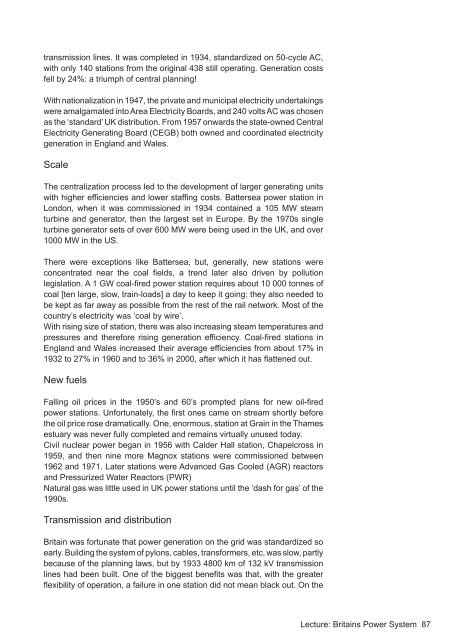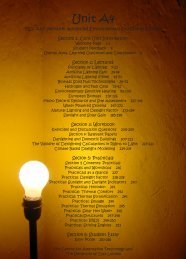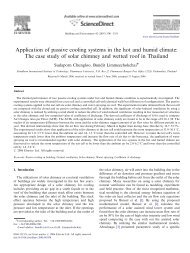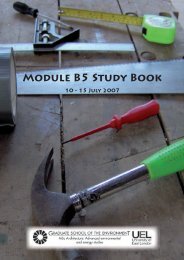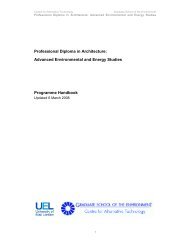Module B1 Study Book - the Graduate School of the Environment
Module B1 Study Book - the Graduate School of the Environment
Module B1 Study Book - the Graduate School of the Environment
You also want an ePaper? Increase the reach of your titles
YUMPU automatically turns print PDFs into web optimized ePapers that Google loves.
transmission lines. It was completed in 1934, standardized on 50-cycle AC,<br />
with only 140 stations from <strong>the</strong> original 438 still operating. Generation costs<br />
fell by 24%: a triumph <strong>of</strong> central planning!<br />
With nationalization in 1947, <strong>the</strong> private and municipal electricity undertakings<br />
were amalgamated into Area Electricity Boards, and 240 volts AC was chosen<br />
as <strong>the</strong> ‘standard’ UK distribution. From 1957 onwards <strong>the</strong> state-owned Central<br />
Electricity Generating Board (CEGB) both owned and coordinated electricity<br />
generation in England and Wales.<br />
Scale<br />
The centralization process led to <strong>the</strong> development <strong>of</strong> larger generating units<br />
with higher efficiencies and lower staffing costs. Battersea power station in<br />
London, when it was commissioned in 1934 contained a 105 MW steam<br />
turbine and generator, <strong>the</strong>n <strong>the</strong> largest set in Europe. By <strong>the</strong> 1970s single<br />
turbine generator sets <strong>of</strong> over 600 MW were being used in <strong>the</strong> UK, and over<br />
1000 MW in <strong>the</strong> US.<br />
There were exceptions like Battersea, but, generally, new stations were<br />
concentrated near <strong>the</strong> coal fields, a trend later also driven by pollution<br />
legislation. A 1 GW coal-fired power station requires about 10 000 tonnes <strong>of</strong><br />
coal [ten large, slow, train-loads] a day to keep it going: <strong>the</strong>y also needed to<br />
be kept as far away as possible from <strong>the</strong> rest <strong>of</strong> <strong>the</strong> rail network. Most <strong>of</strong> <strong>the</strong><br />
country’s electricity was ‘coal by wire’.<br />
With rising size <strong>of</strong> station, <strong>the</strong>re was also increasing steam temperatures and<br />
pressures and <strong>the</strong>refore rising generation efficiency. Coal-fired stations in<br />
England and Wales increased <strong>the</strong>ir average efficiencies from about 17% in<br />
1932 to 27% in 1960 and to 36% in 2000, after which it has flattened out.<br />
New fuels<br />
Falling oil prices in <strong>the</strong> 1950’s and 60’s prompted plans for new oil-fired<br />
power stations. Unfortunately, <strong>the</strong> first ones came on stream shortly before<br />
<strong>the</strong> oil price rose dramatically. One, enormous, station at Grain in <strong>the</strong> Thames<br />
estuary was never fully completed and remains virtually unused today.<br />
Civil nuclear power began in 1956 with Calder Hall station, Chapelcross in<br />
1959, and <strong>the</strong>n nine more Magnox stations were commissioned between<br />
1962 and 1971. Later stations were Advanced Gas Cooled (AGR) reactors<br />
and Pressurized Water Reactors (PWR)<br />
Natural gas was little used in UK power stations until <strong>the</strong> ‘dash for gas’ <strong>of</strong> <strong>the</strong><br />
1990s.<br />
Transmission and distribution<br />
Britain was fortunate that power generation on <strong>the</strong> grid was standardized so<br />
early. Building <strong>the</strong> system <strong>of</strong> pylons, cables, transformers, etc, was slow, partly<br />
because <strong>of</strong> <strong>the</strong> planning laws, but by 1933 4800 km <strong>of</strong> 132 kV transmission<br />
lines had been built. One <strong>of</strong> <strong>the</strong> biggest benefits was that, with <strong>the</strong> greater<br />
flexibility <strong>of</strong> operation, a failure in one station did not mean black out. On <strong>the</strong><br />
Lecture: Britains Power System 87


